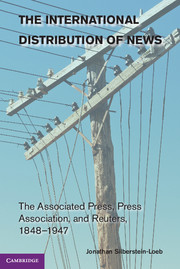 The International Distribution of News
The International Distribution of News Published online by Cambridge University Press: 05 July 2014
For centuries the supply of news has been protected from market forces. Various institutional arrangements have provided protection by subsidizing the provision of news. Direct government grants or subventions have been relatively rare. Although at various times during the nineteenth century political patronage of the press was commonplace in Britain and the United States, rarely was it sustained. Instead, subsidies were largely indirect. A classic example, about which much has been written, is postal subsidies for the distribution of newspapers. Postal subsidies have a long history stretching back to seventeenth-century England. A group of post office officials called the Clerks of the Road could frank newspapers for domestic and foreign distribution, which were then free from postage. For this service they charged newspapers a small fee, which they pocketed personally. In the American colonies and later in the United States, the Post Office also subsidized the distribution of newspapers. With successive developments in telecommunications, such as telegraphy and radio broadcasting, new institutional arrangements were devised that protected the supply of news. The twin subsidies of cooperation and exclusivity and the way in which state action and business activities shaped these subsidies are the focus of this book. Looking closely at the processes by which newspapers obtained news provides a clearer sense of how the supply of news was funded.
Cooperation subsidized the supply of news in two ways. First, by cooperating, newspaper publishers could share with each other the costs of gathering news. During the 1850s and 1860s, the promise of reduced telegraphy costs encouraged newspapers around the world to form associations to collect news. These associations occupied the top of the news pyramid. They supplied reports of breaking news to newspapers and other news outlets such as newsrooms and later radio stations. In turn, these reports either formed the basis for further reporting or were reproduced verbatim. The British Press Association (PA), established in 1868, is the oldest surviving news association. The American Associated Press (AP), incorporated in 1892, grew out of several regional news associations that emerged across the United States during the 1840s, 1850s, and 1860s. In these associations the cost of collecting the news was apportioned among the members of the association according to their respective use of the news reports. The assessments levied on the newspapers were in turn used to meet the costs of supplying the news.
To save this book to your Kindle, first ensure no-reply@cambridge.org is added to your Approved Personal Document E-mail List under your Personal Document Settings on the Manage Your Content and Devices page of your Amazon account. Then enter the ‘name’ part of your Kindle email address below. Find out more about saving to your Kindle.
Note you can select to save to either the @free.kindle.com or @kindle.com variations. ‘@free.kindle.com’ emails are free but can only be saved to your device when it is connected to wi-fi. ‘@kindle.com’ emails can be delivered even when you are not connected to wi-fi, but note that service fees apply.
Find out more about the Kindle Personal Document Service.
To save content items to your account, please confirm that you agree to abide by our usage policies. If this is the first time you use this feature, you will be asked to authorise Cambridge Core to connect with your account. Find out more about saving content to Dropbox.
To save content items to your account, please confirm that you agree to abide by our usage policies. If this is the first time you use this feature, you will be asked to authorise Cambridge Core to connect with your account. Find out more about saving content to Google Drive.